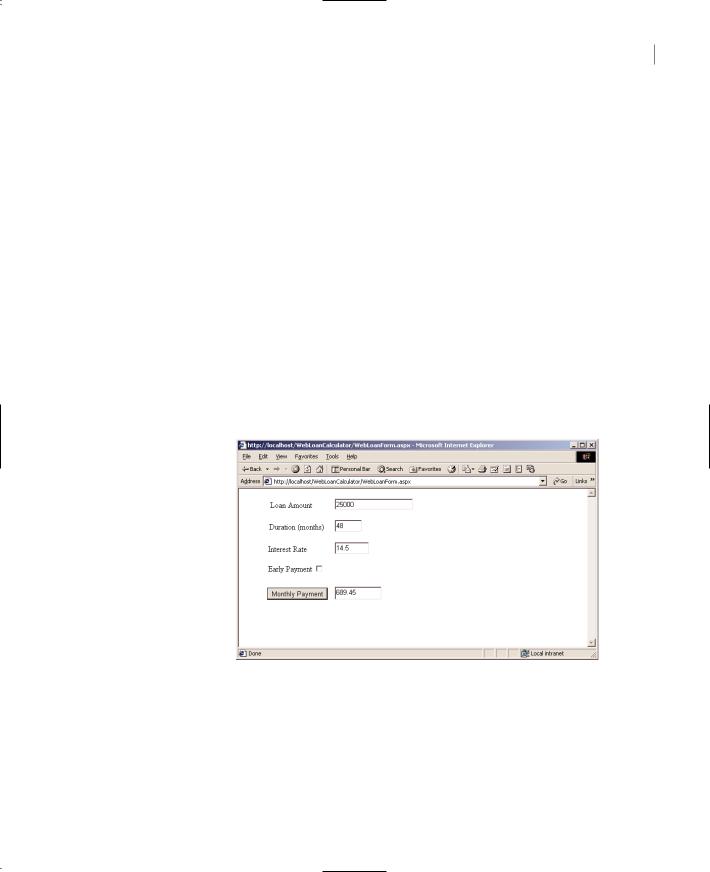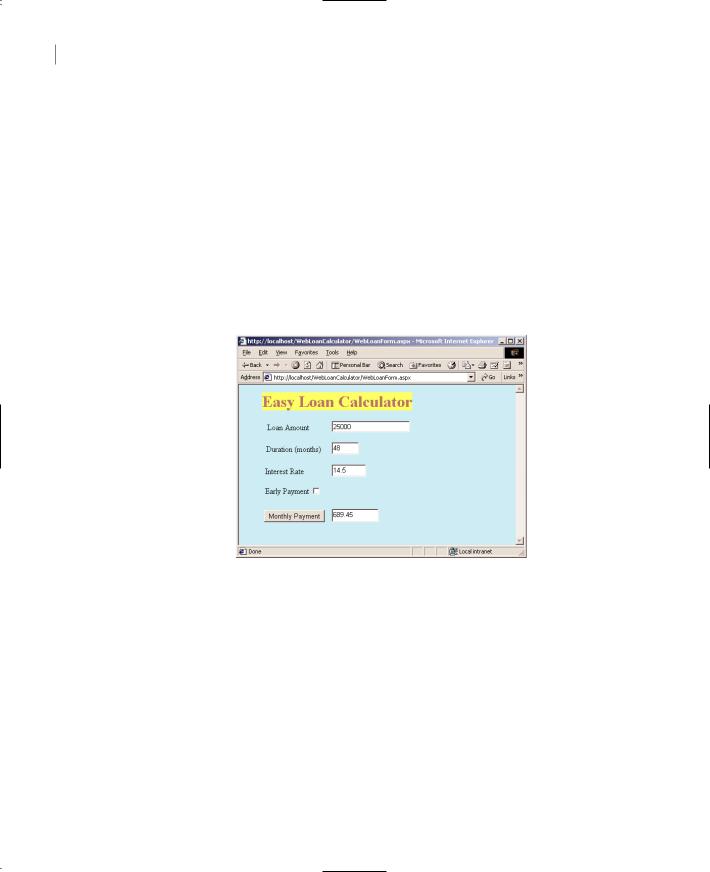
- •Using Your Sybex Electronic Book
- •Acknowledgments
- •Contents at a Glance
- •Introduction
- •Who Should Read This Book?
- •How About the Advanced Topics?
- •The Structure of the Book
- •How to Reach the Author
- •The Integrated Development Environment
- •The Start Page
- •Project Types
- •Your First VB Application
- •Making the Application More Robust
- •Making the Application More User-Friendly
- •The IDE Components
- •The IDE Menu
- •The Toolbox Window
- •The Solution Explorer
- •The Properties Window
- •The Output Window
- •The Command Window
- •The Task List Window
- •Environment Options
- •A Few Common Properties
- •A Few Common Events
- •A Few Common Methods
- •Building a Console Application
- •Summary
- •Building a Loan Calculator
- •How the Loan Application Works
- •Designing the User Interface
- •Programming the Loan Application
- •Validating the Data
- •Building a Math Calculator
- •Designing the User Interface
- •Programming the MathCalculator App
- •Adding More Features
- •Exception Handling
- •Taking the LoanCalculator to the Web
- •Working with Multiple Forms
- •Working with Multiple Projects
- •Executable Files
- •Distributing an Application
- •VB.NET at Work: Creating a Windows Installer
- •Finishing the Windows Installer
- •Running the Windows Installer
- •Verifying the Installation
- •Summary
- •Variables
- •Declaring Variables
- •Types of Variables
- •Converting Variable Types
- •User-Defined Data Types
- •Examining Variable Types
- •Why Declare Variables?
- •A Variable’s Scope
- •The Lifetime of a Variable
- •Constants
- •Arrays
- •Declaring Arrays
- •Initializing Arrays
- •Array Limits
- •Multidimensional Arrays
- •Dynamic Arrays
- •Arrays of Arrays
- •Variables as Objects
- •So, What’s an Object?
- •Formatting Numbers
- •Formatting Dates
- •Flow-Control Statements
- •Test Structures
- •Loop Structures
- •Nested Control Structures
- •The Exit Statement
- •Summary
- •Modular Coding
- •Subroutines
- •Functions
- •Arguments
- •Argument-Passing Mechanisms
- •Event-Handler Arguments
- •Passing an Unknown Number of Arguments
- •Named Arguments
- •More Types of Function Return Values
- •Overloading Functions
- •Summary
- •The Appearance of Forms
- •Properties of the Form Control
- •Placing Controls on Forms
- •Setting the TabOrder
- •VB.NET at Work: The Contacts Project
- •Anchoring and Docking
- •Loading and Showing Forms
- •The Startup Form
- •Controlling One Form from within Another
- •Forms vs. Dialog Boxes
- •VB.NET at Work: The MultipleForms Project
- •Designing Menus
- •The Menu Editor
- •Manipulating Menus at Runtime
- •Building Dynamic Forms at Runtime
- •The Form.Controls Collection
- •VB.NET at Work: The DynamicForm Project
- •Creating Event Handlers at Runtime
- •Summary
- •The TextBox Control
- •Basic Properties
- •Text-Manipulation Properties
- •Text-Selection Properties
- •Text-Selection Methods
- •Undoing Edits
- •VB.NET at Work: The TextPad Project
- •Capturing Keystrokes
- •The ListBox, CheckedListBox, and ComboBox Controls
- •Basic Properties
- •The Items Collection
- •VB.NET at Work: The ListDemo Project
- •Searching
- •The ComboBox Control
- •The ScrollBar and TrackBar Controls
- •The ScrollBar Control
- •The TrackBar Control
- •Summary
- •The Common Dialog Controls
- •Using the Common Dialog Controls
- •The Color Dialog Box
- •The Font Dialog Box
- •The Open and Save As Dialog Boxes
- •The Print Dialog Box
- •The RichTextBox Control
- •The RTF Language
- •Methods
- •Advanced Editing Features
- •Cutting and Pasting
- •Searching in a RichTextBox Control
- •Formatting URLs
- •VB.NET at Work: The RTFPad Project
- •Summary
- •What Is a Class?
- •Building the Minimal Class
- •Adding Code to the Minimal Class
- •Property Procedures
- •Customizing Default Members
- •Custom Enumerations
- •Using the SimpleClass in Other Projects
- •Firing Events
- •Shared Properties
- •Parsing a Filename String
- •Reusing the StringTools Class
- •Encapsulation and Abstraction
- •Inheritance
- •Inheriting Existing Classes
- •Polymorphism
- •The Shape Class
- •Object Constructors and Destructors
- •Instance and Shared Methods
- •Who Can Inherit What?
- •Parent Class Keywords
- •Derived Class Keyword
- •Parent Class Member Keywords
- •Derived Class Member Keyword
- •MyBase and MyClass
- •Summary
- •On Designing Windows Controls
- •Enhancing Existing Controls
- •Building the FocusedTextBox Control
- •Building Compound Controls
- •VB.NET at Work: The ColorEdit Control
- •VB.NET at Work: The Label3D Control
- •Raising Events
- •Using the Custom Control in Other Projects
- •VB.NET at Work: The Alarm Control
- •Designing Irregularly Shaped Controls
- •Designing Owner-Drawn Menus
- •Designing Owner-Drawn ListBox Controls
- •Using ActiveX Controls
- •Summary
- •Programming Word
- •Objects That Represent Text
- •The Documents Collection and the Document Object
- •Spell-Checking Documents
- •Programming Excel
- •The Worksheets Collection and the Worksheet Object
- •The Range Object
- •Using Excel as a Math Parser
- •Programming Outlook
- •Retrieving Information
- •Recursive Scanning of the Contacts Folder
- •Summary
- •Advanced Array Topics
- •Sorting Arrays
- •Searching Arrays
- •Other Array Operations
- •Array Limitations
- •The ArrayList Collection
- •Creating an ArrayList
- •Adding and Removing Items
- •The HashTable Collection
- •VB.NET at Work: The WordFrequencies Project
- •The SortedList Class
- •The IEnumerator and IComparer Interfaces
- •Enumerating Collections
- •Custom Sorting
- •Custom Sorting of a SortedList
- •The Serialization Class
- •Serializing Individual Objects
- •Serializing a Collection
- •Deserializing Objects
- •Summary
- •Handling Strings and Characters
- •The Char Class
- •The String Class
- •The StringBuilder Class
- •VB.NET at Work: The StringReversal Project
- •VB.NET at Work: The CountWords Project
- •Handling Dates
- •The DateTime Class
- •The TimeSpan Class
- •VB.NET at Work: Timing Operations
- •Summary
- •Accessing Folders and Files
- •The Directory Class
- •The File Class
- •The DirectoryInfo Class
- •The FileInfo Class
- •The Path Class
- •VB.NET at Work: The CustomExplorer Project
- •Accessing Files
- •The FileStream Object
- •The StreamWriter Object
- •The StreamReader Object
- •Sending Data to a File
- •The BinaryWriter Object
- •The BinaryReader Object
- •VB.NET at Work: The RecordSave Project
- •The FileSystemWatcher Component
- •Properties
- •Events
- •VB.NET at Work: The FileSystemWatcher Project
- •Summary
- •Displaying Images
- •The Image Object
- •Exchanging Images through the Clipboard
- •Drawing with GDI+
- •The Basic Drawing Objects
- •Drawing Shapes
- •Drawing Methods
- •Gradients
- •Coordinate Transformations
- •Specifying Transformations
- •VB.NET at Work: Plotting Functions
- •Bitmaps
- •Specifying Colors
- •Defining Colors
- •Processing Bitmaps
- •Summary
- •The Printing Objects
- •PrintDocument
- •PrintDialog
- •PageSetupDialog
- •PrintPreviewDialog
- •PrintPreviewControl
- •Printer and Page Properties
- •Page Geometry
- •Printing Examples
- •Printing Tabular Data
- •Printing Plain Text
- •Printing Bitmaps
- •Using the PrintPreviewControl
- •Summary
- •Examining the Advanced Controls
- •How Tree Structures Work
- •The ImageList Control
- •The TreeView Control
- •Adding New Items at Design Time
- •Adding New Items at Runtime
- •Assigning Images to Nodes
- •Scanning the TreeView Control
- •The ListView Control
- •The Columns Collection
- •The ListItem Object
- •The Items Collection
- •The SubItems Collection
- •Summary
- •Types of Errors
- •Design-Time Errors
- •Runtime Errors
- •Logic Errors
- •Exceptions and Structured Exception Handling
- •Studying an Exception
- •Getting a Handle on this Exception
- •Finally (!)
- •Customizing Exception Handling
- •Throwing Your Own Exceptions
- •Debugging
- •Breakpoints
- •Stepping Through
- •The Local and Watch Windows
- •Summary
- •Basic Concepts
- •Recursion in Real Life
- •A Simple Example
- •Recursion by Mistake
- •Scanning Folders Recursively
- •Describing a Recursive Procedure
- •Translating the Description to Code
- •The Stack Mechanism
- •Stack Defined
- •Recursive Programming and the Stack
- •Passing Arguments through the Stack
- •Special Issues in Recursive Programming
- •Knowing When to Use Recursive Programming
- •Summary
- •MDI Applications: The Basics
- •Building an MDI Application
- •Built-In Capabilities of MDI Applications
- •Accessing Child Forms
- •Ending an MDI Application
- •A Scrollable PictureBox
- •Summary
- •What Is a Database?
- •Relational Databases
- •Exploring the Northwind Database
- •Exploring the Pubs Database
- •Understanding Relations
- •The Server Explorer
- •Working with Tables
- •Relationships, Indices, and Constraints
- •Structured Query Language
- •Executing SQL Statements
- •Selection Queries
- •Calculated Fields
- •SQL Joins
- •Action Queries
- •The Query Builder
- •The Query Builder Interface
- •SQL at Work: Calculating Sums
- •SQL at Work: Counting Rows
- •Limiting the Selection
- •Parameterized Queries
- •Calculated Columns
- •Specifying Left, Right, and Inner Joins
- •Stored Procedures
- •Summary
- •How About XML?
- •Creating a DataSet
- •The DataGrid Control
- •Data Binding
- •VB.NET at Work: The ViewEditCustomers Project
- •Binding Complex Controls
- •Programming the DataAdapter Object
- •The Command Objects
- •The Command and DataReader Objects
- •VB.NET at Work: The DataReader Project
- •VB.NET at Work: The StoredProcedure Project
- •Summary
- •The Structure of a DataSet
- •Navigating the Tables of a DataSet
- •Updating DataSets
- •The DataForm Wizard
- •Handling Identity Fields
- •Transactions
- •Performing Update Operations
- •Updating Tables Manually
- •Building and Using Custom DataSets
- •Summary
- •An HTML Primer
- •HTML Code Elements
- •Server-Client Interaction
- •The Structure of HTML Documents
- •URLs and Hyperlinks
- •The Basic HTML Tags
- •Inserting Graphics
- •Tables
- •Forms and Controls
- •Processing Requests on the Server
- •Building a Web Application
- •Interacting with a Web Application
- •Maintaining State
- •The Web Controls
- •The ASP.NET Objects
- •The Page Object
- •The Response Object
- •The Request Object
- •The Server Object
- •Using Cookies
- •Handling Multiple Forms in Web Applications
- •Summary
- •The Data-Bound Web Controls
- •Simple Data Binding
- •Binding to DataSets
- •Is It a Grid, or a Table?
- •Getting Orders on the Web
- •The Forms of the ProductSearch Application
- •Paging Large DataSets
- •Customizing the Appearance of the DataGrid Control
- •Programming the Select Button
- •Summary
- •How to Serve the Web
- •Building a Web Service
- •Consuming the Web Service
- •Maintaining State in Web Services
- •A Data-Driven Web Service
- •Consuming the Products Web Service in VB
- •Summary

58 Chapter 2 VISUAL BASIC PROJECTS
Listing 2.10: The Revised Equals Button
Private Sub bttnEquals_Click(ByVal sender As System.Object, _
ByVal e As System.EventArgs) Handles bttnEquals.Click Dim result As Double
Operand2 = Val(lblDisplay.Text) Try
Select Case Operator Case “+”
result = Operand1 + Operand2 Case “-”
result = Operand1 - Operand2 Case “*”
result = Operand1 * Operand2 Case “/”
If Operand2 <> “0” Then result = Operand1 / Operand2 End Select
lblDisplay.Text = result Catch exc As Exception
MsgBox(exc.Message) lblDisplay.Text= “ERROR”
Finally
clearDisplay = True End Try
End Sub
Most of the time, the error handler remains inactive and doesn’t interfere with the operation of the program. If an error occurs, which most likely will be an overflow error, the error-handling section of the Try…Catch…End Try statement will be executed. This code displays a message box with the description of the error, and it also displays the string “ERROR” on the display. The Finally section is executed regardless of whether an exception occurred or not. In this example, the Finally section sets the clearDisplay variable to True so that when another digit button is clicked, a new number will appear on the display.
Note The exc variable represents an exception; it exposes a few properties in addition to the Message property, which is the description of the exception. For more information on the members of the Exception class and how to handle exceptions, see Chapter 17.
Taking the LoanCalculator to the Web
In this section, we’re going to build a new project that is a loan calculator just like the one we built earlier. This time, though, the application will run on the browser, and any user who can connect to your server will be able to use it without having to install it on their computer. As you can understand, you’re about to convert the LoanCalculator from a Windows application to a Web application. It’s a
Copyright ©2002 SYBEX, Inc., Alameda, CA |
www.sybex.com |

TAKING THE LOANCALCULATOR TO THE WEB 59
little early in the book to discuss Web applications, but I wanted to show you that building a Web application is quite similar to building a Windows app.
Web applications are discussed in detail in the last part of the book, but since they’re among the hot new features of the .NET platform, let me demonstrate why they are so hot. In a sentence, Visual Studio.NET is the first attempt to make the development of Web applications as easy as VB applications. You will see shortly that you can create the interface of a Web form (an HTML page with controls that interact with the user) just as you create a Windows form. As for the application’s code, it’s just like writing VB code to handle the events of a Windows form.
To write and test Web applications, you must have Internet Information Server (IIS) installed and running on your computer. IIS is distributed with Windows 2000, and you must make sure it’s running. Open the Start menu and select Settings Control Panel. Double-click the Administrative Tools, then double-click the icon of the Internet Services Manager tool. When the Internet Services Manager window appears, expand the node of your computer, right-click the Default Web Site item, and from the context menu, select Start. This will start the Web server.
Start a new project and, on the New Project dialog box, click the ASP.NET Web Application icon. Then enter the name of the application in the Name box—call it WebLoanCalculator. When you close the New Project dialog box, you will see a window with a grid as usual, which represents the Web page, or Web form. This document is called WebForm1.aspx (the default name of the Web form). The Web form is equivalent to the Windows form, but it’s displayed as HTML on a browser such as Internet Explorer, as you see in Figure 2.7.
Figure 2.7
The WebLoanCalculator Web application
A new Windows project is stored in its own folder under the folder specified in the Location field on the New Project dialog box. Web applications are also stored in their own folder, but this folder is created under the Web server’s root folder (usually the C:\Inetpub\wwwroot folder).
Opening a Web project is not as simple as double-clicking the icon of a Solution file. I suggest you follow the steps described in this chapter to create the project. If you want to open the WebLoanCalculator project on the CD, copy the entire WebLoanCalculator folder into the Web Server’s root folder. Then start Visual Studio.NET and open the WebLoanCalculator solution file.
Copyright ©2002 SYBEX, Inc., Alameda, CA |
www.sybex.com |

60 |
Chapter 2 VISUAL BASIC PROJECTS |
The text describes how to create the project from scratch. The application’s main form is called WebLoanForm.aspx (it’s equivalent to a Windows form). You can open the application by starting Internet Explorer and enter the following URL in its Address box:
http://localhost/WebLoanCalculator/WebLoanForm.aspx
Let me describe the process of building the Web application from scratch. Change the name of WebForm1 to WebLoanForm. Open the Toolbox, and you see that the Web Forms tab is activated, instead of the Windows Forms tab. The Web Forms tab contains the icons of the controls you can place on a Web form, which are similar to the Windows controls but not as elaborate or as rich in functionality. As you already know, Web pages use a much simpler user-interaction model. The viewer can enter text on certain controls, check or clear a few options, and click a button to submit the form to the server. The server reads the values on the controls, processes them, and returns a new page with the results. In the future, you can expect that applications running over the Internet will become more and more elaborate, but for now no one questions the HTML model used so far. As long as the browser can only handle HTML files, the Web application’s front end is confined to HTML pages.
There’s another tab on the Toolbox, the HTML tab. These are the standard HTML controls you can use on any Web page. The Web Forms tab contains the so-called Web controls, and there are quite a few Web controls, as opposed to the rather limited number of HTML controls. Some of the Web controls are also quite advanced compared to the really limited capabilities of the HTML controls. Does this mean that a page that contains Web controls can’t be displayed on a browser other than Internet Explorer? Not at all. Web controls are translated automatically into standard HTML code that can be rendered on any browser. For example, on the Web Forms tab you’ll find some very elaborate controls, such as the TreeView control. HTML doesn’t provide any controls that come even near the functionality of TreeView. Yet a Web TreeView control can be rendered on any browser. The Web Forms Designer will insert the appropriate HTML tags to create something that looks and behaves like the TreeView control—but it’s not a TreeView control. There’s a lot to be said about Web controls, but you’ll have to wait until the last part of the book. For now, we’ll build a simple application that uses Web controls to prompt the user for the parameters of a loan and that will display the monthly payment on the same page, just like a Windows application.
Start by placing four Label controls on the Web form. (Double-click the Label control’s icon on the Toolbox four times, and four labels be placed on the Web form for you.) Change their placement on the form by arranging them with the mouse, just as you would do with the controls on a Windows form. You don’t have to align them perfectly now; you’ll use the commands of the Format menu to align the controls on the form. Just place them roughly at positions shown in Figure 2.7. Then select each Label with the mouse and, in the Properties window, locate the Text property of the control.
As you can see, most of the basic properties of the Web controls have the same name as the Windows controls. Change the captions of the four labels to “Loan Amount,” “Duration (months),” “Interest,” and ‘Monthly Payment.” Notice that the Label Web control is resized automatically to accommodate the string you assign to its Text property.
Now place four TextBox controls on the Web form, each next to one of the Labels. By default, all TextBox controls are empty (they have no initial content). Change their size with the mouse and
Copyright ©2002 SYBEX, Inc., Alameda, CA |
www.sybex.com |

TAKING THE LOANCALCULATOR TO THE WEB 61
align them roughly to the Label controls they correspond to. Then select them one at a time and change their ID property to txtAmount, txtDuration, txtRate, and txtPayment, respectively. The ID property of a Web control is the unique identifier of the control, similar to the Name property of a Windows control. You’ll use the ID property to access the control’s members from within your code.
Then place a CheckBox control, set its Text property to Early Payment, and name it chkPayEarly. Set its TextAlign property to Left, so that its check box will be placed to the right of the text. The check box will be drawn immediately after the text, so you have to append a few spaces to the control’s caption to clearly separate it from the check box.
The last control to place on the form is the Button control, whose Text property will be “Monthly Payment” and Name property will be bttnShowPayment. This button will submit the loan parameters entered on the form to the server, where the appropriate code will calculate the monthly payment and return it to the client. This is a good point to align the controls on the Web form. Select the Label controls and align them left with the Format Align Lefts command. While the labels are selected, use Format Vertical Spacing Make Equal to space them equally from one another. Once the labels are in place, you can align each text box to the corresponding label, with the Format Align Middles command. Select a pair of a Label and a TextBox control at a time and align them. Just make sure that the Label control is used as the reference control for the alignment.
At this point, you’re done designing the interface of the application. The interface is quite similar to the interface of the equivalent Windows application, only this one was designed on a Web form with Web controls. Other than that, the process was the same; even the tools for aligning the controls on the Web form are the same as those for the Windows form. Our next task is to program the application.
Double-click the button on the Web form, and the editor window will open. The Web Form Designer has selected the Click event of the button and inserted its definition. All you have to do is insert the same code we used in the LoanCalculator application. You can switch to the Windows application and copy the code (which was shown back in Listing 2.2). Just paste the code behind the Show Payment button of the LoanCalculator Windows application in the Click event handler of the Monthly payment button of the Web application, and there won’t be a single error. You can reuse the code as is!
Press F5 to run the application. It will be several seconds before the Internet Explorer window will pop up, displaying the page you’ve designed. Enter the parameters of a loan and then click the Monthly Payment button. A few seconds later, the monthly payment will appear on the form. As you will notice, a totally new page will arrive in the browser; this page contains the parameters of the loan (the values you’ve entered on the form) and the result of the calculations.
If you look at the source code of the document shown on Internet Explorer, you will see straight HTML code. The interface of the WebLoanCalculator application looks fine, but not quite like
a Web page. There’s none of the color or graphics we’re so accustomed to seeing on Web pages. Our Web form contains only controls, but it’s an HTML page and you can add any element that could appear on a Web page. In other words, the Web form can be edited as an HTML document. Not only that, but the IDE allows you to edit your page either visually or in HTML mode. Let’s add a colored caption and change the page’s background color.
Select the Web form by clicking somewhere on the form. In the Properties window, locate the property pageLayout. Its setting is GridLayout, which explains why you were able to place the controls anywhere on the page and align them in all possible ways. Those of you familiar with HTML know that aligning controls on a Web form is anything but trivial. Change the pageLayout property
Copyright ©2002 SYBEX, Inc., Alameda, CA |
www.sybex.com |

62 |
Chapter 2 VISUAL BASIC PROJECTS |
from GridLayout to FlowLayout. Now you’re in normal HTML editing mode. Place the cursor at the top of the page and start typing. Enter the string Easy Loan Calculator and then select it with the mouse. You will notice that the text-formatting buttons on the toolbar have been enabled. Set the text’s size to 6 and set its foreground and background colors. To set these properties, use the two buttons next to the Bold/Italic/Underline group of buttons. The string is flush left on the form, so enter a few spaces in front of the string to center it above the controls.
Note A quick comment for readers familiar with HTML: Browsers ignore multiple spaces, but the editor silently converts the spaces you enter into codes, which are the HTML equivalent of “hard”—that is, nonbreaking—spaces.
You can also change the color of the page. Locate the page’s bgColor property in the Properties window and set it to a light color. When the Color Picker dialog box appears on the form, you will see the tab with the Web colors. These are the colors than can be displayed by all browsers, the socalled safe colors. The form now looks like Figure 2.8 when viewed in a browser.
Figure 2.8
The WebLoan-
Calculator as a
Web page
To see how the Web Form Designer handles the HTML elements of the page, click the HTML button at the bottom of the Designer. The Web form can be viewed and designed either in Design view (which is the default view) or in HTML view. The Web Form Designer inserted the following statement in the HTML document to generate the header of the page:
<FONT style=”BACKGROUND-COLOR: #ffff66” color=”#996666” size=”6”> <STRONG>Easy Loan Calculator</STRONG></FONT>
This is straight HTML code that could appear in any Web page, and it doesn’t use any Web controls. Select the <FONT> tag and delete it. Then switch to the Design view to see that the header has disappeared. Switch back to the HTML view and insert the following statement right after the <body> tag and before the <form> tag, as shown in Figure 2.9:
<h1>Easy Loan Calculator</h1>
Copyright ©2002 SYBEX, Inc., Alameda, CA |
www.sybex.com |
